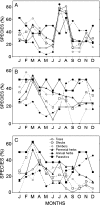Reproductive phenology of 233 species from four herbaceous-shrubby communities in the Gran Sabana Plateau of Venezuela
- PMID: 22476484
- PMCID: PMC3144378
- DOI: 10.1093/aobpla/plr014
Reproductive phenology of 233 species from four herbaceous-shrubby communities in the Gran Sabana Plateau of Venezuela
Abstract
Background and aims: Herbaceous-shrubby communities in the Gran Sabana (Great Savanna) Plateau of Venezuela grow under non-zonal conditions. We speculated that this would produce specific patterns of reproductive phenology within these different soil-climate-vegetation associations. Specifically, we tested the hypothesis that the reproductive phenology patterns of four herbaceous-shrubby communities are determined by climate, plant life-forms and soil properties.
Methodology: The reproductive phenology of 233 plant species of the Gran Sabana Plateau of the Venezuelan Guayana Highlands was studied taking into account their life-forms (i.e. trees, shrubs, climbers, annual herbs, perennial herbs, epiphytes and parasites/hemiparasites) in four herbaceous-shrubby communities: (i) shrubland, (ii) secondary bush, (iii) savanna and (iv) broad-leaved meadow. Patterns of flowering, and occurrence of unripe fruit and ripe fruit were studied at two levels of intensity for 24 months within a 5-year span. Two phenological records for each month of the year and between two and four replicates for each community type were made. Randomly selected 2-3 ha plots were used. General phenological patterns were established using <25% of the plants of each species in each plot to give the total duration of each phenological phase. High-intensity phenological patterns were established using >25% of individuals in each plot to establish times of high abundance of flowers, and presence of unripe fruit and/or ripe fruit on individual plants. This generated phenological peaks for each species.
Principal results: Non-seasonality of general flowering and unripe fruiting in each of the four communities was related to non-seasonal flowering and unripe fruiting patterns in the plant life-forms studied and to low variation in precipitation throughout the year. Flowering activity in the shrubland and broad-leaved meadow peaked twice. The bush community had only one flowering peak while the savanna gave a non-seasonal flowering peak. The peak unripe fruiting pattern was not clearly related to unripe fruit phenological patterns of the most abundant life-forms. Unripe fruit patterns and precipitation were only correlated for shrubs, climbers and trees in the shrubland. Ripe fruiting patterns peaked during the short-dry season in the bush and shrubland, and were negatively correlated with precipitation in the shrubland. General and peak ripe fruiting patterns were non-seasonal in the savanna and broad-leaved meadow and related to the dominance of herbaceous species with prolonged ripe fruiting times, low climate seasonality, high plant species richness and diversity, and dispersal syndromes.
Conclusions: The reproductive phenology of the herbaceous-shrubby communities is mainly influenced by the composition of the life-forms, the precipitation regime and soil type.
Figures





Similar articles
-
Outbreeding and inbreeding strategies in herbaceous-shrubby communities in the Venezuelan Gran Sabana Plateau.AoB Plants. 2019 Jun 26;11(4):plz032. doi: 10.1093/aobpla/plz032. eCollection 2019 Aug. AoB Plants. 2019. PMID: 31308924 Free PMC article.
-
Reproductive phenology, life-forms, and habitats of the Venezuelan Central Plain.Am J Bot. 2002 May;89(5):836-42. doi: 10.3732/ajb.89.5.836. Am J Bot. 2002. PMID: 21665684
-
[Reproductive phenology of three vegetation types from a coastal plain of Paraguana Penninsula, Venezuela].Acta Cient Venez. 2002;53(4):266-78. Acta Cient Venez. 2002. PMID: 12945492 Spanish.
-
Diversity of flowering and fruiting phenology of trees in a tropical deciduous forest in India.Ann Bot. 2006 Feb;97(2):265-76. doi: 10.1093/aob/mcj028. Epub 2005 Dec 15. Ann Bot. 2006. PMID: 16357055 Free PMC article.
-
Cascading effects of climate extremes on vertebrate fauna through changes to low-latitude tree flowering and fruiting phenology.Glob Chang Biol. 2015 Sep;21(9):3267-77. doi: 10.1111/gcb.12869. Epub 2015 Mar 13. Glob Chang Biol. 2015. PMID: 25605302 Review.
Cited by
-
Outbreeding and inbreeding strategies in herbaceous-shrubby communities in the Venezuelan Gran Sabana Plateau.AoB Plants. 2019 Jun 26;11(4):plz032. doi: 10.1093/aobpla/plz032. eCollection 2019 Aug. AoB Plants. 2019. PMID: 31308924 Free PMC article.
References
-
- Anderberg MR. Cluster analysis for applications. In: Birbaum W, Lukacs E, editors. Probability and mathematical statistics. Vol. 19. New York: Academic Press; 1973. A series of monographs and textbooks.
-
- Batalha MA, Martins FR. Reproductive phenology of the cerrado plant community in Emas National Park (Central Brazil) Australian Journal of Botany. 2004;52:149–161. doi:10.1071/BT03098. - DOI
-
- Bawa KS, Kang H, Grayum MH. Relationships among time, frequency, and duration of flowering in tropical rain forest trees. American Journal of Botany. 2003;90:877–887. doi:10.3732/ajb.90.6.877. - DOI - PubMed
-
- Bhat DM, Murali KS. Phenology of understorey species of tropical moist forest of Western Ghats region of Uttara Kannada district in South India. Current Science. 2001;81:799–805.
-
- Daubenmire R. Phenology and other characteristics of tropical semi-deciduous forest in North-Western Costa Rica. Journal of Ecology. 1972;60:147–170. doi:10.2307/2258048. - DOI
LinkOut - more resources
Full Text Sources

